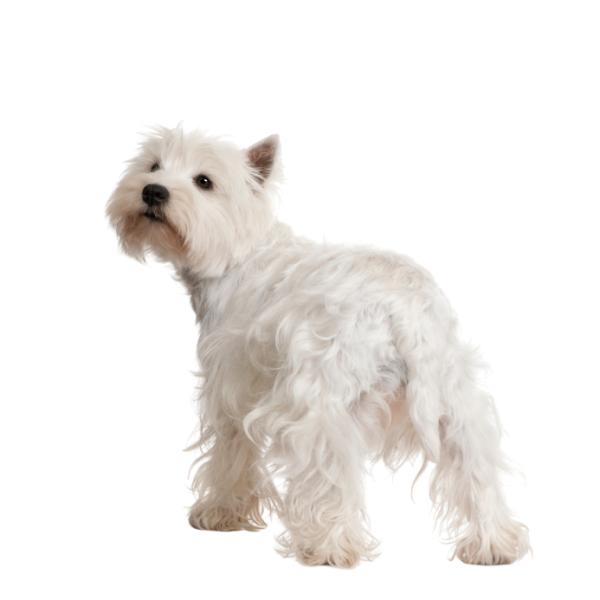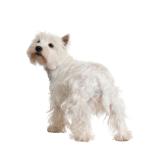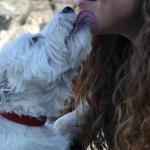West Highland White Terrier

The West Highland White Terrier or Westy, is a small and friendly dog, but crude and brave at the same time. Developed as a hunter dog, nowadays they are one of the best pets in existence. This breed comes from Scotland, more specifically Argyll, and is characterized by their bright white hair. They appeared in the early twentieth century fruit of the offspring between cairn terrier specimens that had white and cream hair. At first the breed was used for fox hunting although soon they became the excellent companion dog that we now know.
They are very affectionate and sociable dogs, so they are ideal for families with children, who can give them much company and affection. In addition, this breed only needs moderate physical activity. So, it is perfectly fine to have a westy in a small flat or house if you provide them with their daily dose of walks. If you want to adopt a West Highland White Terrier, this AnimalWised breed file will help you solve all your doubts.
- Europe
- United Kingdom
- Group III
- 5-14
- 14-18
- 18-22
- 22-27
- 27-31
- More than 31
- 2-7
- 7-22
- 22-55
- 55-100
- 100-220
- 8-10
- 10-12
- 12-14
- 15-20
- Low
- Meidum
- High
Origin of the West Highland White Terrier
This breed originated in the highlands of western Scotland, hence the name! Initially, the breed was not distinguished from other short-legged Scottish terriers such as the Cairn, Dandie Dinmont and the Scottish terrier. However, with the passage of time each variety was raised separately, to constitute true dog breeds.
These terriers were originally bred as dogs for fox and badger hunting, and had coats of different colors. It is said that Colonel Edward Donald Malcolm decided to only breed the white dogs after one of his red dogs died after being mistaken for a fox. If the legend is true, this would indeed be the reason that all Westies are white.
In 1907 this breed was presented for the first time in the prestigious dog show Crufts. Since then, the west highland white terrier has enjoyed wide acceptance in canine competitions and in thousands of homes worldwide.
Physical Characteristics
The Westy is a small dog, ideal for those living in a flat as they measure about 28 centimeters to the cross and usually do not exceed 10 kg in weight. Usually females are somewhat smaller than males. This is a small, compact dog, but strong in structure. The loin is level (straight) and the back is broad and strong, while the chest is deep. The legs are short, muscular and strong.
The head of the west highland white terrier is a little bulging and is covered with abundant fur. The nose is black and somewhat elongated. The teeth are large in relation to the size of the dog and very powerful - a useful feature for fox hunting in its burrow. Their eyes are medium and dark and have an intelligent and alert expression. A Westy's face is sweet and friendly and they seem to always be alert because of their little pointed ears. The tail is a typical and much appreciated element of the West Highland's appearance. It is covered with abundant rough hair and is very straight. It is shaped like a small carrot, is between 12.5 and 15 centimeters in length and should not be cut.
The most remarkable feature of the West Highland is its beautiful white hair (the only color accepted), which is divided into an inner layer of soft and dense hair that contrasts with an outer layer of thick and somewhat rough hair. The outer layer usually grows to 5-6 centimeters, making it imperative to go to the hairdresser somewhat regularly. The Teddy hairstyle is popular for this breed.
Temperament
Brave, rogue, very self-confident and dynamic, the westie is perhaps the most affectionate and sociable of all the terrier dogs. Still, you have to keep in mind that it is a rough dog designed for hunting dangerous animals such as the fox. Although it will depend on each specimen, the Westy usually relates perfectly with other dogs thanks to their balanced temperament and friendly nature. It is important, just like with any dog, that they are socialized properly from a young age in parks and nearby surroundings to meet other pets and people.
We must know that this wonderful dog is also the perfect companion of children, with whom they will enjoy an active rhythm of play. If our intention is to adopt a dog so that our children enjoy spending time with their pet, we must be clear on the importance of their small size. A game too rough can end up with a broken leg. We must educate them so that the game between pet and children is adequate. In addition, they tend to bark and dig, so they can cause issues for those who like extreme silence and a well-kept garden. However, they are excellent pets for dynamic people who enjoy outdoor activities.
The Westy is an active and affectionate dog who will love to feel part of the family nucleus. They are very accommodating and affectionate dogs with those who take care of them every day. Sweet and restless, the Westy will love to take you for a walk in the countryside or the mountain, even as an old dog. They will bring to light their past as a hunting dog if they find an interesting trace that they can follow. It will also be imperative that you play with them regularly to maintain their agility and intelligence.
Caring for a West Highland White Terrier
West Highland skin is somewhat dry and bathing too frequently can make them prone to rashes. We will try to avoid this problem by washing them with a regularity of 3 weeks approximately with a specifically designed shampoo for the breed. After the bath you will dry their ears well with a towel, a part of their body that needs regular cleaning.
Hair brushing should also be regular to keep their coat healthy and shiny. In addition, brushing is pleasant for most dogs, so we are confident this will strengthen your bond with one another. Although the maintenance of the hair is not so complicated, the westie tends to get dirty easily as they are completely white. It is normal for our Westy to dirty their snout or legs after eating or playing. A trick is to use baby wipes to clean the area. Also pay attention to tear stains that they can accumulate.
It is not a dog that needs large amounts of exercise. For that reason, two or three walks daily at an active pace will be enough to have our West Highland happy and healthy. Because of their small size, this dog can exercise inside the house, but enjoys playing outdoors, in a fenced-in area. In addition, it is important to provide this dog with all the company they need. Since they are very sociable animals, they need to be with theri family as much time as possible, and it is not good to leave them alone for prolonged periods.
Training
Westies tend to be friendly to people and can get along with other dogs when they have been properly socialized. Their strong prey drive, however, makes them unfit to tolerate small pets, which tend to hunt. However, it is important to initiate the socialization of dogs at an early age, to prevent future problems of shyness or aggressiveness. The strong personality of these small dogs has led many to think that it is difficult to train them, but that is not true. They are very intelligent dogs that learn quickly when they are trained through postitive methods such as clicker training. They do not respond well to traditional training techniques based on punishment and negative reinforcement. Positive reinforcement is highly recommended. You just need regular training because they are usually quite independent. they are always alert of their territory, ready to defend it, for that reason we affirm that they are excellent watchdogs.
Health
Westy puppies are especially vulnerable to craniomandibular osteopathy (also known as lion's jaw), a disease that consists of abnormal growth of the jaw. It is genetic and should be treated properly with the help of a veterinarian. It usually appears about 3-6 months of age and disappears at 12, after the application of corticosteroids or natural remedies is complete. It is rarely severe.
Other diseases that your West Highland may suffer from are balloon cell leukodystrophy or Legg-Calve-Perthes disease. Westies is also susceptible, but less frequently, to cataracts, patellar luxation, and copper toxicosis.
West Highland White Terrier photos




















 Thank you for all the information on Westies. It was very helpful . My little girl is 5 years old now, she was trained to be a service dog at the age of 4 mo old. She did a great job. I have some health issues and she is there for me to alert me. I dont think I could do with out her in my life. ( We go everywhere together from Grocery Shopping, to my Dr appointments, to the beach, even to church. I m a senior and she is my daughter I never had and my best friend . I feel so safe with her by my side.
Thank you for all the information on Westies. It was very helpful . My little girl is 5 years old now, she was trained to be a service dog at the age of 4 mo old. She did a great job. I have some health issues and she is there for me to alert me. I dont think I could do with out her in my life. ( We go everywhere together from Grocery Shopping, to my Dr appointments, to the beach, even to church. I m a senior and she is my daughter I never had and my best friend . I feel so safe with her by my side.













